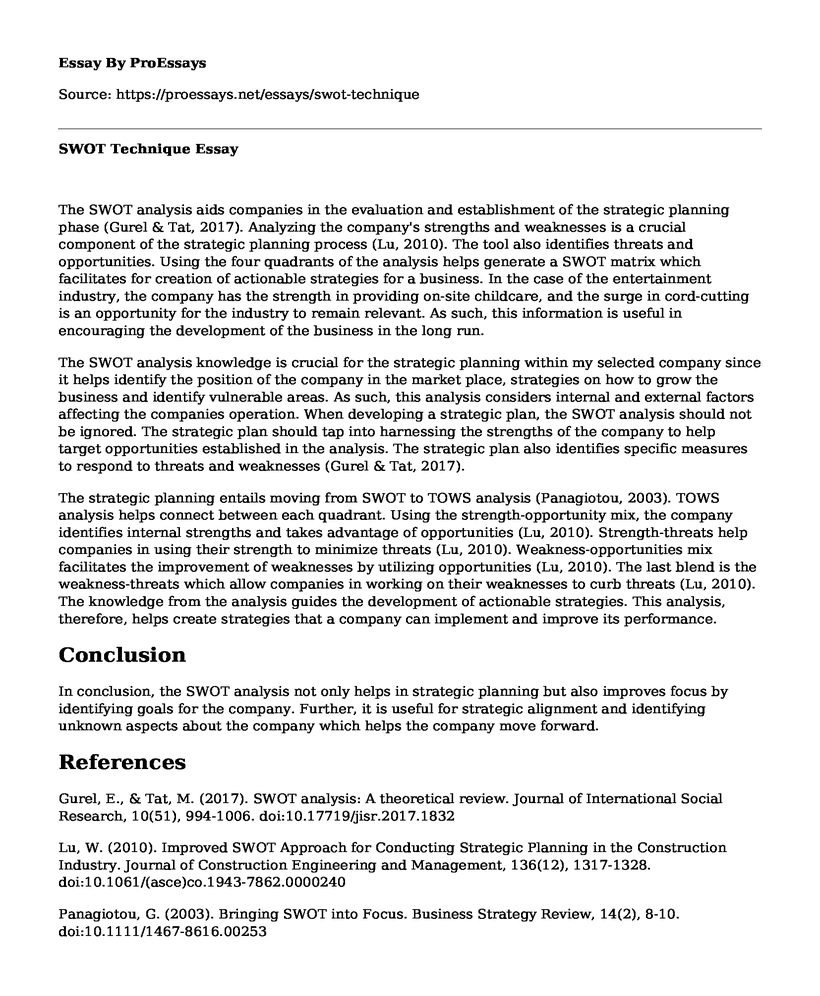The SWOT analysis aids companies in the evaluation and establishment of the strategic planning phase (Gurel & Tat, 2017). Analyzing the company's strengths and weaknesses is a crucial component of the strategic planning process (Lu, 2010). The tool also identifies threats and opportunities. Using the four quadrants of the analysis helps generate a SWOT matrix which facilitates for creation of actionable strategies for a business. In the case of the entertainment industry, the company has the strength in providing on-site childcare, and the surge in cord-cutting is an opportunity for the industry to remain relevant. As such, this information is useful in encouraging the development of the business in the long run.
The SWOT analysis knowledge is crucial for the strategic planning within my selected company since it helps identify the position of the company in the market place, strategies on how to grow the business and identify vulnerable areas. As such, this analysis considers internal and external factors affecting the companies operation. When developing a strategic plan, the SWOT analysis should not be ignored. The strategic plan should tap into harnessing the strengths of the company to help target opportunities established in the analysis. The strategic plan also identifies specific measures to respond to threats and weaknesses (Gurel & Tat, 2017).
The strategic planning entails moving from SWOT to TOWS analysis (Panagiotou, 2003). TOWS analysis helps connect between each quadrant. Using the strength-opportunity mix, the company identifies internal strengths and takes advantage of opportunities (Lu, 2010). Strength-threats help companies in using their strength to minimize threats (Lu, 2010). Weakness-opportunities mix facilitates the improvement of weaknesses by utilizing opportunities (Lu, 2010). The last blend is the weakness-threats which allow companies in working on their weaknesses to curb threats (Lu, 2010). The knowledge from the analysis guides the development of actionable strategies. This analysis, therefore, helps create strategies that a company can implement and improve its performance.Conclusion
In conclusion, the SWOT analysis not only helps in strategic planning but also improves focus by identifying goals for the company. Further, it is useful for strategic alignment and identifying unknown aspects about the company which helps the company move forward.
References
Gurel, E., & Tat, M. (2017). SWOT analysis: A theoretical review. Journal of International Social Research, 10(51), 994-1006. doi:10.17719/jisr.2017.1832
Lu, W. (2010). Improved SWOT Approach for Conducting Strategic Planning in the Construction Industry. Journal of Construction Engineering and Management, 136(12), 1317-1328. doi:10.1061/(asce)co.1943-7862.0000240
Panagiotou, G. (2003). Bringing SWOT into Focus. Business Strategy Review, 14(2), 8-10. doi:10.1111/1467-8616.00253
Cite this page
SWOT Technique. (2022, Mar 19). Retrieved from https://proessays.net/essays/swot-technique
If you are the original author of this essay and no longer wish to have it published on the ProEssays website, please click below to request its removal:
- Article Analysis: Existentialism: Basic Reading
- Primary Research Analysis of Cultural Anthropology Article
- Views on Richard Rodriguez's Criticism Towards Bilingual Education in the United States
- Essay Sample on Murphy, Chuma, Mathews, Steyn, & Levitt's Study
- Criticism and Analysis of Hamlet
- Essay Example on Data Collection & Assess for Student Evaluation: Essential Steps
- Business Environment Gets Competitive and Volatile







